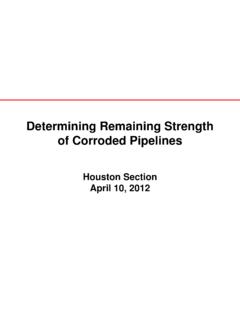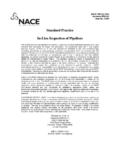Transcription of Further guidance on emergency plans for major accident ...
1 Further guidance on emergency plansfor major accident hazard pipelinesThe Pipelines Safety Regulations 1996 ContentsPart 1 - emergency planning Introduction General Pipelines Safety Regulations 1996 Scope of an emergency plan for pipelines HSE's arrangements to notify a local authority Aim of an emergency plan Objectives of an emergency plan Preparation of an emergency plan emergency arrangements, procedures and plans Information in the event of an emergency Testing emergency plans and procedures8 Part 2 - emergency plans for pipeline Planning for pipeline failure Causes of pipeline failure Probability of pipeline failure and duration of pipeline leaks hazards and effects of pipeline Fire and explosion Toxic effects Blast effects and projectiles Cryogenic effects Asphyxiation Noise Hazard range and emergency planning distance Worst credible, or reference.
2 Accidents 15 Appendix 1 Extracts from pipeline Safety Regulations 1996 and guidance publication L82 17 Appendix 2 Sample format of letter used to notify local authorities of a pipeline20 Appendix 3 Content and structure of pipeline emergency plans - an example 21 Glossary25 References27 Further information28 This guidance is issuedby the Health andSafety the guidanceis not compulsory andyou are free to takeother action. But if youdo follow the guidanceyou will normally bedoing enough tocomply with the and safetyinspectors seek tosecure compliance withthe law and may referto this guidance asillustrating and Safety ExecutivePart 1 - emergency Pipelines Safety Regulations 1996 (PSR)1require a local authority to prepareemergency plans for pipelines which have the potential to cause a major accident . The Regulations also require a pipeline operator to establish emergency procedures forsuch Health and Safety Executive (HSE) guidance booklet L822provides advice onHSE s interpretation of the Regulations and how they will be enforced.
3 The purpose ofthis document is to amplify that advice, especially in relation to the roles of localauthorities and pipeline operators in preparing emergency guidance document considers in more detail the nature of pipeline hazards ,some technical aspects of major accident hazard pipelines and the likelihood andconsequences of pipeline failure to assist and inform local authorities when preparingemergency are considered a safe mode of transportation for conveying hazardoussubstances and are often safer than alternative methods, for example, by road and , there are occasions when pipeline failure results in loss of containment oraccidental release of the pipeline contents. emergency plans are required to provide anadditional safeguard so that, in the unlikely event of an emergency involving a majoraccident hazard pipeline , protection could be provided to members of the publicwhose health and safety might be Safety Regulations 19965 These Regulations apply to all relevant pipelines and are designed to ensure thatpipelines are designed, constructed, operated, maintained and decommissioned conveying dangerous fluids , defined in Schedule 2 of the Regulations,are referred to as major accident hazard pipelines (MAHP) and the followingsummarises the additional regulations which apply:nrequirements for emergency shut-down valves on certain major accident hazardpipelines connected to offshore installations (regulation 19);nnotification, by the pipeline operator, to HSE prior to construction, use, or changeto a pipeline (regulations 20, 21 and 22).
4 Npreparation of a major accident prevention document (MAPD) by the pipelineoperator in which hazards are identified, risks assessed and where there aresufficient particulars to demonstrate that the safety management system isadequate (regulation 23);nthe pipeline operator to ensure that appropriate emergency procedures,organisation and arrangements are in place (regulation 24);nregulation 25 requires a local authority which has been notified by HSE of amajor accident hazard pipeline to prepare an emergency plan ;nregulation 26 allows a local authority which prepares, reviews or revises aplan to charge a fee to the operator of the of 28 pagesFurther guidance on emergency plans for major accident hazard pipelinesHealth and Safety Executive3 of 28 pagesFurther guidance on emergency plans for major accident hazard pipelinesHealth and Safety ExecutiveNote: Regulations 25 and 26, together with extracts from the guidance to theRegulations (L82) are reproduced in Appendix 3 defines the meaning of pipeline .
5 An emergency plan has to applyto all parts of a major accident hazard pipeline - not just the buried pipe example, natural gas pipelines will include block valve sites, pig trap sites,offtakes, pressure reduction stations and compressor stations. However, sites usedfor storage (eg gas holder stations) and gas terminals are not part of the pipeline .8 There is no explicit requirement in the Regulations to test an emergency plandrawn up under regulation 25 (but see also section ). This was recognised asanoutstanding issue by the Health and Safety Commission (HSC) when theRegulations came into of an emergency plan for pipelines9 The Pipelines Safety Regulations, made under the Health and Safety at Worketc. Act 1974,3do not cover environmental consequences of pipeline failures. TheRegulations only require an emergency plan to be prepared to deal with eventsinvolving a major accident hazard pipeline and which are a danger to the healthand safety of However, a local authority may elect to extend the scope of its emergencyarrangements to cover environmental, economic and other consequences followingthe failure of a major accident hazard pipeline but any work undertaken inpreparation for these parts of the plan cannot be charged to the pipeline operatorunder regulation 26 of PSR.
6 Also, local authorities may take the view that certainkinds of environmental effects or damage have the potential to cause harm topeople and should be included in the local authority may elect to extend the scope of its arrangements to deal withthose pipelines not defined as major accident hazard pipelines, for example, thosecarrying flammable liquids (eg gasoline, hexane, kerosene, diesel, dead crude oil,methanol etc), but no charge can be made to operators of these pipelines underregulation 26 of The scope of emergency plans does not include actions to be taken in theevent of loss of gas supply to gas consumers. These are matters covered by theGas Safety (Management) Regulations 19964which deal with the safe managementof gas supply. Many of these kinds of events will probably involve the medium orlow pressure gas distribution systems which operate at or below 7 bar gauge (ie 8bar absolute) and fall outside the scope of the additional duties under 's arrangements to notify a local authority13 pipeline operators have a duty under regulations 20 and 22 of PSR to notifyHSE of their intention to construct, or make changes to, a major accident hazardpipeline and, in turn, HSE has to inform the relevant local authorities so that anemergency plan can be prepared or : If a pipeline is no longer to be a major accident hazard pipeline by virtue of achange in the conveyed fluid or fluid properties etc, then the pipeline operator shallnotify HSE under regulation 22 of PSR.
7 HSE will, in turn, inform the relevant localauthority(ies) that an emergency plan for that pipeline is no longer required underthe of 28 pagesFurther guidance on emergency plans for major accident hazard pipelinesHealth and Safety Executive14 These notifications are made to the Hazardous Installations Directorate (HID) Local authorities are then informed of new pipelines or changes to pipelines viathe HID Unit Inspection Teams which are located throughout the country (contactHSE s Infoline for details Tel: 0845 345 0055. Out of hours emergency contactnumber: 0151 922 9235). Receipt of the notification should act as a trigger for thelocal authority to prepare an emergency plan for a Normally, a notification to a local authority will be in the form of a letter (seeAppendix 2 for an example), accompanied by the following information:nthe name of the pipeline operator;nthe contact details of the pipeline operator;nthe pipeline identifier, which may be a description or number;nthe name of the pipeline or the pipeline start and finish points; andnthe fluid to be A copy of the notification is sent by HSE to the pipeline If a local authority wishes to consult with HSE during the preparation of anemergency plan , or has any queries or requests for Further information, advice orassistance, then contact should be made, in the first instance, with the local HIDUnit Inspection Team (contact HSE s Infoline for details Tel: 0845 345 0055).
8 Of an emergency plan19 For the purposes of PSR, the aim of an emergency plan can be described as: To detail action to be taken to minimise the consequences to the health and safetyof people in the event of an emergency involving a major accident hazard pipeline . of an emergency plan20 The objectives of an emergency plan are to:nhave simplicity and a clear structure to ensure all users understand theprinciples of its operation;nreduce the risks to the health and safety of all those affected by an emergency (both immediately and potentially), including members of the public andemergency services personnel;nidentify those measures needed to contain the effects of the emergency ;nensure a robust process is in place for the management of the emergencyresponse following a pipeline accident and which clearly identifies the localauthority, emergency services and pipeline operator responsibilities;nmanage the emergency to minimise the effects on the activities of those notdirectly affected, for example, traffic control to keep people out of the area andto prevent people congregating at the scene thereby putting themselves at risk.
9 Naddress in detail the communication requirements between the emergencyservices and pipeline operator;nensure rapid and appropriate restoration of those affected once the emergencyis over;nrecognise the continuous 24-hour-a-day operation of pipelines and themultiplicity of potential incident locations. The plan should be flexible enough toprovide emergency response at any time and at any location along the pipelineroute;naddress in principle credible pipeline failures within the emergency planningdistance but be flexible enough to take into account other events that areextremely unlikely and where the consequences may extend beyond theemergency planning distance (see section );nbe compatible with those drawn up for major accident hazard sites under theControl of major accident hazards Regulations 1999 (COMAH) (as amended),5,6especially where pipelines are connected to such sites;ndeal effectively with pipelines which cross local authority boundaries - somelonger pipelines may cross a large number of local authority of an emergency plan21 Local authorities should consult with the pipeline operator, HSE and others In general, it will be the pipeline operator who will be able to provide themajority of the pipeline related information required for the preparation of a information provided by HSE when notifying local authorities is intentionallylimited and does not include maps, details of the hazard range or emergencyplanning distance - it is designed to trigger a dialogue between the local authorityand pipeline operator.
10 The pipeline operator should be able to provide up-to-dateinformation on the pipeline route and should, by virtue of its major accidentprevention document, be able to provide sufficient details of pipeline hazards andthe results of any risk assessment. This information will form the basis fordetermining both the hazard range and detailed emergency planning distance (seesection ).23It is particularly important that early contact is made by the local authoritywith the pipeline operator to develop an understanding of the nature of thepipeline, the hazards and the consequences of potential failure, theemergency response management requirements and responsibilities and toidentify what resources will be required by the authority to prepare the scope, content and development cost of the emergency plan should bediscussed and agreed with the pipeline operator. It is important that consultationand liaison with the pipeline operator are maintained during the preparation of theplan.














